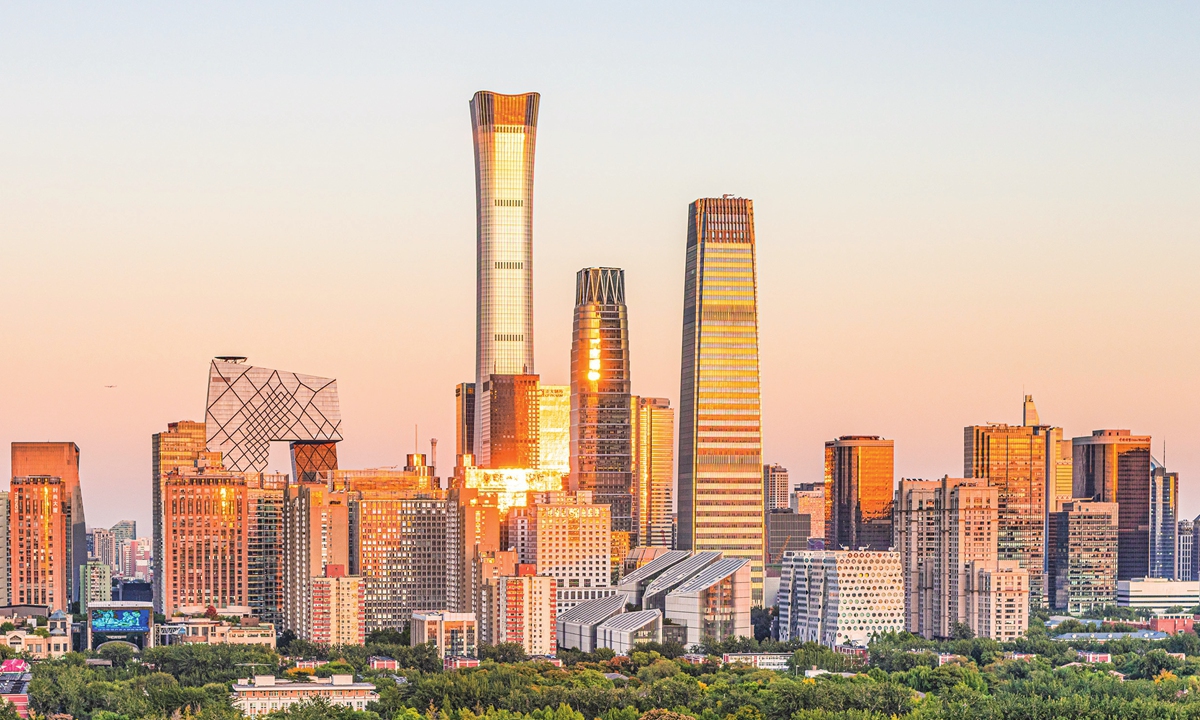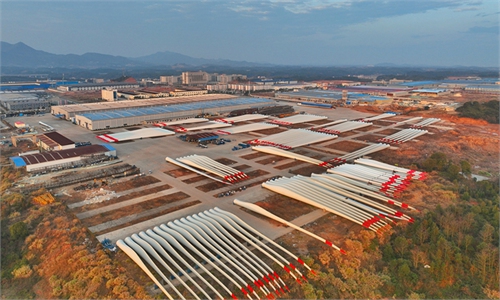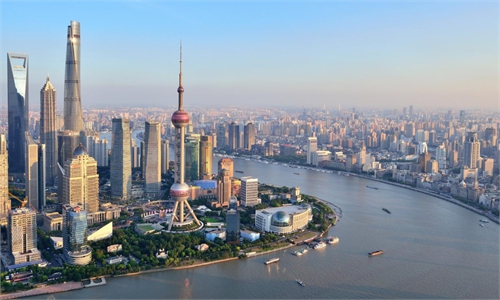China's top economic planner vows to ramp up measures to secure growth as Q1 result shines, despite West's 'Peak China' hype

A view of the skyline of Beijing's CBD area. Photo: VCG
China's top economic planner, the National Development and Reform Commission (NDRC), announced a series of stimulus measures to further boost the economy as the country achieved a better-than-expected result of GDP growth of 5.3 percent in the first quarter, a reflection of the good start to the year and an indication of the stronger momentum ready to be unleashed.
Supportive efforts, including facilitating investment plans through the central budget and promoting additional treasury bond issuances, are part of the government work plan to consolidate growth for the rest of the year, according to officials.
While there are lingering challenges, mainly due to a complicated external environment, inadequate demand and weak social expectations for the economy, the country's economic development in the long-run remains solid with steady progress being made, thanks to the supportive polices and consumption upgrade among other factors, officials and experts said, defying the West's "Peak China" rhetoric on the Chinese economy.
More supportive policies
Speaking at a press conference of the State Council Information Office on Wednesday, Liu Sushe, deputy head of the NDRC, vowed to implement a series of specific policy measures to shore up the economy.
The government will facilitate the trade-in action plan, implement ultra-long-term special treasury bonds and promote foreign investment while deepening comprehensive reform and expanding high-level opening-up to the outside world, according to Liu.
Specifically, the government is speeding up the investment plans from within the central budget. This year, the central budget will allocate 700 billion yuan ($96.7 billion) for investment. As of now, more than 200 billion yuan of these funds have been allocated, accounting for over 30 percent of the annual total, Liu said.
Based on this foundation, Liu noted that the NDRC will further speed up the issuance of plans, strengthen implementation of these plans, and at the same time conscientiously do a good job in project construction and supervision. The NDRC will continue to improve the efficiency of investment within the central budget.
In addition, through government investment and policy incentives, more investment from the whole of society is expected to be driven in an effective way.
Specific works include fully leveraging the role of the government and a social capital cooperation project information system that has been launched nationwide, and effectively implementing the new mechanism of government and social capital cooperation.
These remarks came as the nation just unveiled its GDP growth rate for the first three months, recording year-on-year growth of 5.3 percent, reaching 29.63 trillion yuan ($4.09 trillion), according to data released by the National Bureau of Statistics (NBS) on Tuesday, marking a good rebound and kicking off a good start to the year.
Experts noted the effect of government policy efforts in shoring up the economy have been reflected in the Q1 results, and they expected more supportive policies to be rolled out.
Positive macroeconomic policies such as combining relatively loose monetary policy with fiscal support have been a boost to the stable economy, Cao Heping, an economist at Peking University, told the Global Times on Wednesday.
Li Chang'an, a professor at the Academy of China Open Economy Studies of the University of International Business and Economics, told the Global Times that the government's proactive efforts on rolling out more macroeconomic supportive policies are needed to ensure the robust economic growth continues.
In addition to the policies that are in place, Li said that measures such as increasing the implementation of fiscal policies and adopting prudent monetary policies, such as adjusting reserve ratio requirements and interest rates as part of structural adjustments, will help boost economic development.
Responding to the follow-up efforts from the government to bolster the economy, Liu said that the NDRC will strengthen guidance on expectations, enhance market confidence and make every effort to consolidate and enhance the positive economic recovery, while promoting high-quality completion of the annual economic and social development goals and tasks.
'Peak China' rhetoric untenable
Despite the positive economic performance in the first three months and the consistent government policies in place, some Western media and organizations are still hyping the "Peak China" rhetoric, claiming that the world's second-largest economy has peaked in terms of economic growth and is going down.
For example, a recent report by US ratings agency Fitch said that it has revised the outlook on China's Long-Term Foreign-Currency Issuer Default Rating to Negative from Stable.
The related rhetoric exhibits strong rigid thinking, Song Guoyou, deputy director of the Center for American Studies, Fudan University, told the Global Times, responding to the "Peak China" rhetoric, noting that China's GDP growth rate in the first quarter stands out among major global economies, and achieving such data is not a coincidence but a continuation of a trend.
Meanwhile, China's economic potentials are to be further unleashed as adjustments to the country's economic structure is in place to achieve the transition to high-quality development.
Yuan Da, deputy secretary-general of the NDRC, said at Wednesday's press conference that adjusting the economic structure is making progress, giving the example of the accelerated conversion of old and new driving forces.
One good example is the rapid development of the manufacturing industry, which saw a 6.7 percent growth year-on-year. In the sector, the added value of high-tech manufacturing increased by 7.5 percent, with the production in booming sectors such as 3D printing and service robots experiencing double-digit growth, injecting new impetus to economic development for the rest of the year.
Some leading international financial services companies have also lifted their projections for China's economic growth in 2024 in response to the positive results in the first quarter.
UBS raised its forecast for China's real GDP growth in 2024 from 4.6 to 4.9 percent. At the same time, in view of stronger export demand and better-than-expected economic growth in the first quarter, the export (in US dollars) forecast for 2024 is raised to 3.5 percent from the previous growth of 1.2 percent.
The Asian Development Outlook report for 2024 released by the Asian Development Bank predicted that China will contribute 46 percent of the economic growth of developing countries in Asia from 2024 to 2025, and will continue its role as the economy that contributes the most to global economic growth.
Challenges remain
While there are a growing number of positive factors in economic operations, the external environment remains complex, severe and uncertain, with insufficient domestic effective demand and weak social expectations, Liu said at Wednesday's press conference.
The foundation for stable and positive economic development is also not yet solid, posing risks and challenges for economic development, the official further noted.
Also, market demand remains weak. Recent data released by the NBS show that in the first quarter, consumption contributed 73.7 percent to economic growth.
"The growth is mainly driven by consumption, but in terms of investment and foreign trade, the situation has not changed beyond expectations and has not rebounded as significantly as expected," Li said.
One of the main reasons is the complexity of the international situation as China's main trading partners - Europe and the US - have sluggish demand, Li said, noting that China still needs to further improve the quality of foreign trade, adjust its foreign trade structure, and diversify and find new its export markets.
Experts point out that although China's economic development faces many difficulties and challenges, there are more favorable conditions and advantages as the fundamental trend of economic recovery and long-term improvement remains unchanged.
In the first quarter, the Chinese economy got off to a good start, laying a solid foundation for achieving the annual target. With more corresponding policies taking effect, second quarter growth should not be lower than 5.3 percent, continuing its stable upward trajectory, Cao said.
NDRC officials also shared the positive outlook ahead. Answering media questions on the economic outlook for the year, Yuan said that with the continued effectiveness of various policy measures implemented earlier and the implementation of new tasks and measures deployed by the government, the positive momentum of China's economic recovery will be continuously consolidated.



